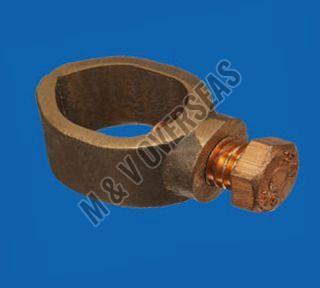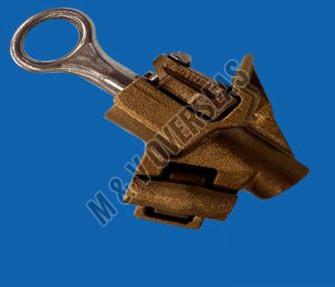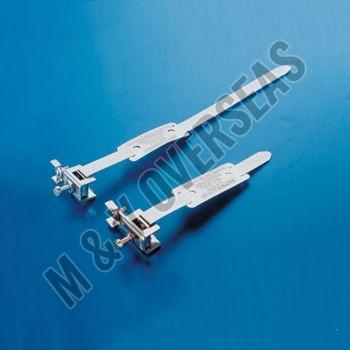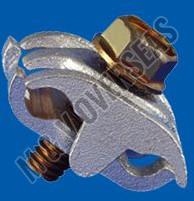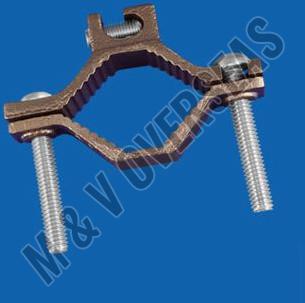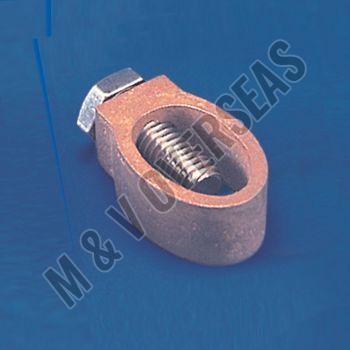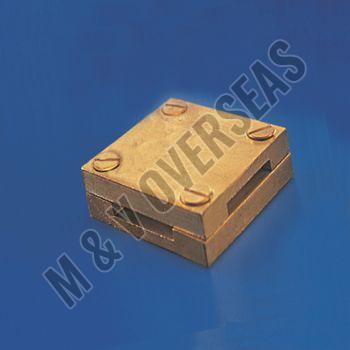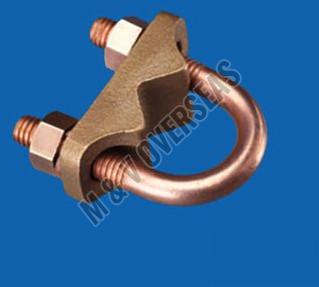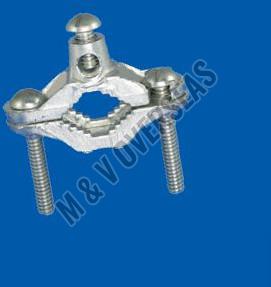View Mobile Number
Metal Clamps
Leading Manufacturers and Wholesaler of Bronze Ground Rod Clamps, Bronze Hot Line Clamp, EC 14 Type Earth Clamps, KUL Bonding Clamp, Rebar Clamp, Rod To Cable Clamp, Rod To Tape A-Clamp, Square Tape Clamp, U Bolt Ground Clamps and Zinc Pipe Clamp from Jamnagar.
| Business Type | Manufacturer, Supplier |
| Material | Bronze |
| Finishing | Polished |
| Application | Industrial |
| Feature | Fine Finishing, High Quality |
| Type | Ground Rod Clamp |
| Country of Origin | India |
Features
- Bronze Construction:As the name suggests, these clamps are typically made of bronze, a material known for its excellent electrical conductivity and resistance to corrosion.
- Screw or Compression Design:Ground rod clamps often use screws or compression mechanisms to tightly and securely fasten the grounding conductor to the ground rod.
- Threaded or Non-Threaded:Some clamps may have threaded holes that accept screws for attaching the grounding conductor, while others may have non-threaded holes that require a separate bolt or threaded rod to make the connection.
| Business Type | Manufacturer, Supplier |
| Material | Bronze |
| Color | Brown |
| Application | Industrial |
| Technics | Casting |
| Country of Origin | India |
Features
- Bronze Construction:These clamps are made of Bronze, a metal known for its excellent electrical conductivity and resistance to corrosion. The bronze material ensures that the clamps can safely carry electrical currents and withstand harsh outdoor conditions.
- Insulated Handles:Hot line clamps usually have insulated handles or grips that provide protection to the user from electric shock while making connections to energized lines.
- Spring-Loaded Mechanism:The clamps often feature a spring-loaded design, allowing them to be easily opened and closed with one hand during installation.
- Toothed Jaws:The jaws of the clamps are toothed or serrated to ensure a secure grip on the conductor or bus bar.
- Safety Features:Bronze hot line clamps may have additional safety features such as “fail-safe” designs or locking mechanisms to prevent accidental detachment from the conductor.
| Business Type | Manufacturer, Supplier |
| Material | Copper |
| Color | Silver |
| Application | Industrial |
| Feature | Electrical Porcelain, Proper Working |
| Type | Earth Clamps |
| Country of Origin | India |
| Business Type | Manufacturer, Supplier |
| Material | Copper Alloy |
| Finishing | Polished |
| Speciality | Compact Size, Perfect Shape |
| Usage | Industrial |
| Country of Origin | India |
| Business Type | Manufacturer, Supplier |
| Material | Copper |
| Application | Industrial |
| Length | 1-1000mm |
| Width | 1-50mm |
| Type | Rebar Clamp |
| Country of Origin | India |
Features
- Mechanical Connection:Rebar clamps create a mechanical connection between two rebars without the need for welding or tying.
- Threaded Design:Most rebar clamps have an internal thread that matches the external thread of the rebar. The threaded ends of the rebars are inserted into the rebar clamp, and the clamp is then tightened, compressing the rebars together to form a secure joint.
- Types:Rebar clamps come in various types, including parallel threaded couplers, tapered threaded couplers, and compression-type couplers. Each type is designed for specific rebar sizes and applications.
- Material:Rebar clamps are commonly made of materials like steel or stainless steel to provide high strength and durability.
- Load Capacity:Rebar clamps are designed to ensure that the joint has the same load-carrying capacity as the original rebar, maintaining the structural integrity of the concrete element.
| Business Type | Manufacturer, Supplier |
| Material | Bronze |
| Surface Finishing | Polished |
| Shape | Oval |
| Application | Industrial |
| Feature | Corrosion Resistance, Dimensional |
| Type | Cable Clamps |
| Country of Origin | India |
Features
- Design: Rod to cable clamps typically consist of two parts—a clamp that securely holds the grounding conductor (cable) and a bolt or screw that connects the clamp to the grounding rod.
- Material: Rod to cable clamps are made of high-conductivity materials, such as Copper or Bronze, to ensure a low-resistance connection.
- Size: The size of the clamp is designed to accommodate the specific diameter of the grounding conductor, ensuring a snug and effective connection.
- Installation: Rod to cable clamps are relatively easy to install. The cable is inserted into the clamp, and the clamp is then secured to the grounding rod using the provided bolt or screw.
- Grounding System: Rod to cable clamps are a critical part of the grounding system, ensuring proper bonding between the grounding conductor and the grounding electrode (rod).
- Lightning Protection: In lightning protection systems, rod to cable clamps are used to connect the lightning protection system’s down conductor (cable) to the grounding rod, providing a safe path for lightning currents to discharge into the ground.
- Electrical Safety: Properly installed rod to cable clamps ensure the continuity of the grounding system, reducing the risk of electrical hazards and providing a reliable path for fault currents.
- Outdoor Applications: Rod to cable clamps are commonly used in outdoor installations, such as utility poles, communication towers, electrical substations, and other grounded structures.
| Business Type | Manufacturer, Supplier |
| Material | Bronze |
| Finishing | Polished |
| Speciality | Compact Size, Perfect Shape |
| Clamp Capacity | 25mm |
| Business Type | Manufacturer, Supplier |
| Material | Brass |
| Finishing | Polished |
| Structural Shape | Square |
| Speciality | Compact Size, Perfect Shape |
| Usage | Industrial |
| Country of Origin | India |
Features
- Design: Square tape clamps are designed to accommodate flat or rectangular conductors, providing a secure and reliable electrical connection.
- Material: Square tape clamps are typically made of high-conductivity materials, such as Copper or tinned Copper, to ensure low-resistance connections.
- Versatility: Square tape clamps come in various sizes to accommodate different dimensions of flat conductors. They are suitable for use with Copper or Aluminium tapes in various applications.
- Termination: Square tape clamps often feature holes or slots to allow for easy termination of the flat conductors using screws, bolts, or other fasteners.
- Electrical Bonding: Square tape clamps are used in bonding applications to establish electrical connections between metallic components, such as structural Steel, equipment enclosures, or pipelines, ensuring equal potential and reducing the risk of electrical hazards.
- Grounding Systems: In grounding systems, square tape clamps are used to connect the grounding conductor (grounding tape) to grounding electrodes, such as ground rods or ground plates, establishing a reliable grounding path.
- Lightning Protection: Square tape clamps play a vital role in lightning protection systems, where they are used to connect the lightning protection tape or conductor to air terminals (lightning rods) and down conductors.
- Easy Installation: Square tape clamps are easy to install and facilitate quick connections, making them a popular choice in various electrical and grounding applications.
| Business Type | Manufacturer, Supplier |
| Material | Copper |
| Shape | U Shape |
| Usage | Pipe Fittings |
| Specialities | Proper Finish, Optimum Durability |
| Country of Origin | India |
Features
- U-shaped Design:U-bolt clamps have a U-shaped configuration with two threaded arms (legs) on each end and a curved base. The shape of the U-bolt allows it to encircle the pipe or tube, creating a secure attachment.
- Threaded Arms:The threaded arms extend from the sides of the U-bolt and have threads that can accept nuts. These nuts are used to fasten the U-bolt to the mounting surface, compressing the U-bolt around the object being clamped.
- Material:U-bolt clamps are commonly made of materials such as steel, stainless steel, or other metals, depending on the application and environmental requirements.
- Pipe Size:U-bolt clamps are available in various sizes to accommodate different pipe or tube diameters.
- Types:There are variou types of U-bolt clamps designed for specific applications, such as standard U-bolt clamps, heavy-duty U-bolt clamps, or U-bolt pipe clamps with rubber linings for vibration dampening.
Application
- Securing pipes or tubes to support structures like beams or channels.
- Fastening cables, wires, or hoses to mounting surfaces.
- Attaching equipment or machinery to fixed structures.
- Creating pipe hangers in plumbing and HVAC installations.
| Business Type | Manufacturer, Supplier |
| Material | Zinc |
| Surface Finishing | Polished |
| Color | Silver |
| Usage | Pipe Fittings |
| Specialities | Sturdiness, Optimum Durability |
| Country of Origin | India |
Features
- Material: Zinc pipe clamps are typically made from Zinc-plated Steel, which provides good corrosion resistance and durability.
- Design: They come in various designs, such as split clamps, hinged clamps, cushioned clamps, or heavy-duty clamps, to suit different pipe sizes and installation requirements.
- Pipe Size: Zinc pipe clamps are available in different sizes to accommodate various pipe diameters, ranging from small plumbing pipes to larger industrial pipelines.
- Installation: Zinc pipe clamps are easy to install and secure to supporting structures, such as walls, ceilings, or beams, using screws, bolts, or other appropriate fasteners.
- Pipe Support: The primary function of Zinc pipe clamps is to support and hold pipes firmly in place, preventing sagging or movement due to the weight of the pipes or the flow of fluids within them.
- Vibration Damping: In some applications, cushioned or rubber-lined Zinc pipe clamps are used to dampen vibrations and reduce noise caused by fluid flow or machinery.
- Temperature Tolerance: Zinc pipe clamps are designed to withstand a wide range of temperatures, making them suitable for both indoor and outdoor applications.
- Plumbing and HVAC: Zinc pipe clamps are commonly used in plumbing systems for water supply and drainage pipes, as well as in HVAC systems for ductwork and refrigerant lines.

